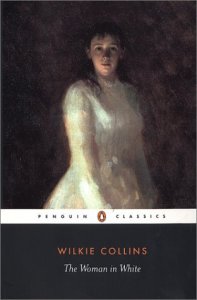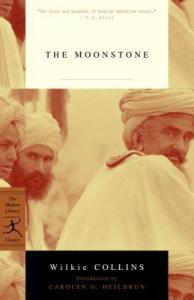
The Woman in White – Wilkie Collins
I’m reading this for my Victorian study group and as you all know I’ve struggled a bit with some of the novels. However, this was very readable quite the page turner!
Here is the summary from Wikipedia (it contains lots of spoilers!)
Walter Hartright, a young art teacher, meets a mysterious and distressed woman dressed in white. He helps her on her way, but later learns that she has escaped from an asylum. Next day, he travels to Limmeridge House in Cumberland, having been hired as a drawing master on the recommendation of his friend, Pesca, an Italian language master. The Limmeridge household comprises the invalid Frederick Fairlie, and Walter’s students: Laura Fairlie, Mr Fairlie’s niece, and Marian Halcombe, her devoted half-sister. Walter realises that Laura bears an astonishing resemblance to the woman in white, who is known to the household and whose name is Anne Catherick. The mentally disabled Anne had lived near Limmeridge as a child and was devoted to Laura’s mother, who first dressed her in white.
Walter and Laura fall in love. Laura, however, has promised her father that she will marry Sir Percival Glyde. Marian – knowing that Laura loves Walter in return – advises Walter to forget his love, and leave Limmeridge. Anne, after sending a letter to Laura warning her against Glyde, meets Walter who becomes convinced (wrongly) that Glyde was Anne’s lover, or was responsible for putting Anne into the asylum. Despite the misgivings of the family lawyer over the financial terms of the marriage settlement, Laura and Glyde marry in December 1849 and travel to Italy for six months. Walter also leaves England, joining an expedition to Honduras. After their honeymoon, Sir Percival and Lady Glyde return to his house, Blackwater Park in Hampshire; they are accompanied by Glyde’s friend, Count Fosco (who is married to Laura’s aunt). Marian is also living at Blackwater and learns that Glyde is in financial difficulties. Glyde unsuccessfully attempts to bully Laura into signing a document which would allow him to use her marriage settlement of £20,000. Glyde reveals to Fosco the resemblance between Laura and Anne, and Fosco and Glyde plot to switch the identities of Laura and the terminally-ill Anne, so that Anne’s death can be passed off as Laura’s and Glyde can inherit. Marian crawls out onto a roof and eavesdrops on Glyde and Fosco, and it begins to rain. Marian becomes soaked, and later falls into a fever which turns into typhus.
While Marian is ill, Laura is tricked into travelling to London. Her identity and Anne’s are then switched. Anne Catherick dies naturally and is buried as Laura; Laura is drugged and “returned” to the asylum as Anne. When Marian visits the asylum, hoping to learn something from Anne, she finds Laura, supposedly suffering from the “delusion” that she is Lady Glyde. Marian bribes the nurse and Laura escapes. Walter has meanwhile returned from Honduras, and the three live together in obscure poverty, determined to restore Laura’s identity. During his researches, Walter discovers that Glyde was illegitimate, and therefore not entitled to inherit his title or property. He has attempted to cover this up by forging an entry in the marriage register, a serious criminal offence. Believing Walter either has discovered or will discover his secret, Glyde attempts to destroy the register entry, but in the process sets the church vestry on fire and perishes in the flames. Confronting Anne’s mother, Walter discovers that Anne was the illegitimate child of Laura’s father, which accounts for their resemblance. Walter suspects that Anne died before Laura’s trip to London (in which case the plot would fail) but is unable to prove of the date of Laura’s journey. However on a visit to the Opera with Pesca, it becomes clear that Fosco belongs to (and has betrayed) an Italian secret society of which Pesca is a high-ranking member who could order his assassination for the betrayal. Fosco seeks to flee the country, but Walter confronts him – having first taken precautions against Fosco’s killing him – and forces a written confession from Fosco, in exchange for letting him leave England unhindered. Laura’s identity can thus be legally restored. Fosco escapes, only to be killed by another agent of the secret society in Paris. Walter and Laura have married earlier, and on the death of Frederick Fairlie, their son becomes the Heir of Limmeridge.
First, like a lot of Victorian novels this novel is long and I think could do with some editing. Also, I think Laura is a bit of a drip and Walter should have fallen in love with Marian (despite her incipient moustache!). However, the way the plot unfolds is brilliant. Various different characters tell the story in different formats – journal entries, statements, etc. Some of the characters reveal quite a bit without being aware (like Mrs Michelson the house keeper at Blackwater). There are devious plans and plot twists – Count Fosco is a fabulous villain – and it seems things will never be put to rights. I guessed some things (it was obvious Anne and Laura would be exchanged at some stage), but that is more than likely because later novels have been influenced by Collins (Fingersmith for example), but other things came as quite a shock (Sir Percival’s parents for example).
I must say I am looking forward to reading The Moonstone.
More reviews …
http://www.theguardian.com/books/booksblog/2009/nov/26/woman-in-white-150-years-sensation
http://literarycornercafe.blogspot.com.au/2011/11/book-review-classics-woman-in-white-by.html


